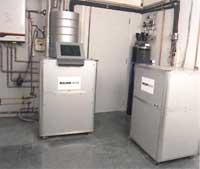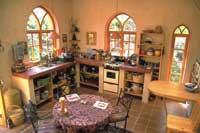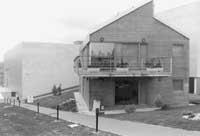Domotics, a reality that seemed fictional
2001/10/01 Kortabarria Olabarria, Beñardo - Elhuyar Zientzia Iturria: Elhuyar aldizkaria
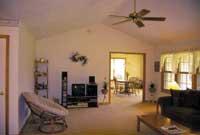
In today's homes there are numerous automatic systems that allow a safer, more comfortable and/or energy-saving life. These systems were developed in the 1980s as a result of industrial automation.
Many of these automatic systems are already known. For example, energy management systems can be found in many homes. The simplest are thermostats, which when reaching the previously programmed temperature, disconnect the heating radiator or the water heating boiler.

Timers and programmers are also found in many homes. These are, for example, the appliances to turn on the heating one hour before you get home or turn it off whenever you want, and the appliances to turn on or off the lights at a certain time. Like these, security automatisms have become very important, such as anti-theft alarms, devices that detect fire or gas or water leaks, etc. If there are more automation systems: remote controls to open doors, answering machines, electric accumulators to save energy…
Therefore, it is clear that at the time the automation of the systems allowed to live more comfortably and more safely in the houses. But development was not limited to that, since then domotics came. One of the new words of the last decade.
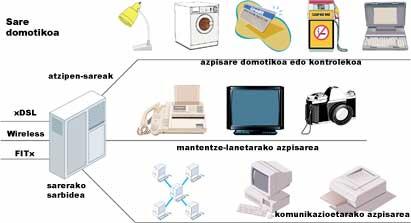
Domotics, in short, consists of grouping automation functions into a single system. The advantage of this integration is that a single installation is needed, that the user learns the operation of a single system, that the user relates to a company and a technical assistance system and, most importantly, that when all the systems are integrated the service is more optimized, for example, when the anti-theft system is launched, the home automation system can understand that the house has become empty and lower several degrees of temperature, saving energy at the same time.
In Euskal Herria there are several companies that have removed the system of home automation networks. Fagor, for example, together with the Ikerlan research centre in Arrasate-Mondragón, has been working in this field for some time. The result of this work has been Fagor Sare Domótica. This network has integrated appliances, heaters, security equipment and communications.

The core of the system is the Domo Mayor, which controls and monitors household appliances via the phone. To give orders, the Domo Mayor uses the electrical installation of the house, so it is not necessary to perform a new installation. The system is completely modular, that is, the user chooses the devices and applications that he wants to introduce in the home automation network. It is the work that the user can do to introduce or remove some element from the network, since it is programmed easily. In fact, in offices and workshops there are people who are in charge of maintenance and installation, but not in homes.
Future technological advantages will benefit the home automation system.
Thus, CENELEC, a European organization that regulates the quality of electrical installations, will launch new regulations to improve the quality of communication through the electrical network of households. These measures will take effect at the end of the year.
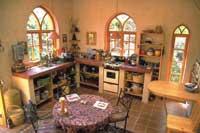
Researchers working on improving home automation facilities, in addition to optimizing the electrical network, have another line of research: radio communications. This type of system has long been known: wireless headphones or traditional control instruments to open garage doors, for example, use radio communication. This type of communication is cheap, but as these use the same radio frequency, numerous interferences occur.
In order to solve these problems, a series of initiatives have been created, one of the most important is the regulations that the new frequency band has implemented. As a result, a frequency band of 868 Mhz has been obtained, within which several subbands have been extracted. Each of them will be for each type of application. For example, sound applications will run through one subfolder, security applications by another, etc. This will at least reduce the competitiveness between applications. In addition, this regulation limits the time of use of these subcards to each application.

Bluetooth, the new radio technology, also has great hope in home automation. In short, Bluetooth technology allows you to connect everything that is connected by cable without using cables. But it is not limited to that. This technology is not only for connecting the mouse, printer or anything else to the computer, but allows you to connect devices that are not directly related and synchronize them automatically. For example, the mobile phone can be used to open doors, to connect with appliances, to bring documents from the phone to the computer, to read counters, etc.
In 1994 manufacturers of mobile phones and computers saw the need for new wireless technology. However, in recent years the mobile phone market has slowed down a lot, fewer electronic devices are being made and it is not being significantly cheaper, so technology has not been cheapened either. Bluetooth technology is slower than initially thought.

However, for the deployment of home automation it is very important that systems of different brands understand each other. Appliances that are usually found in homes are not the same brand, the washing machine can be from one house and the refrigerator from another. Due to its incompatibility, a single home automation installation is not allowed. Therefore, the consumer only has two options: one, to become the slave of a certain brand and another, not to install home automation facilities. Home automation has to standardize, unify language among all devices. If it achieves this level of standardization and the planned development of telecommunications, within a few years domotic houses will be much more abundant than the current ones.

Gai honi buruzko eduki gehiago
Elhuyarrek garatutako teknologia




